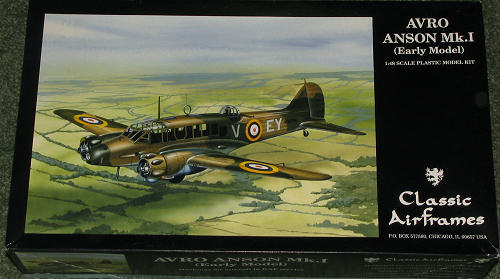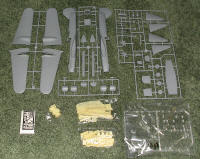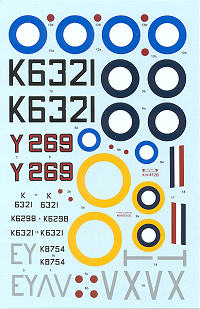
| KIT: | Classic Airframes 1/48 Avro Anson I |
| KIT #: | 4120 |
| PRICE: | $60.00 MSRP |
| DECALS: | Three Options |
| REVIEWER: | Scott Van Aken |
| NOTES: | Multimedia kit with etched metal and resin parts |

| HISTORY |
The Avro Anson was a twin-engine, multi-role aircraft that served with the Royal Air Force, Fleet Air Arm and numerous other air forces during World War II and afterwards. Named for British admiral George Anson, it was originally designed for maritime reconnaissance but was soon rendered obsolete. However it was rescued from obscurity by its suitability as a multi-engine air crew trainer, becoming the mainstay of the British Commonwealth Air Training Plan. By the end of its production life in 1952, the Anson spanned nine variants and a total of 8,138 had been built in Britain by Avro and, from 1941, a further 2,882 by the Canadian Federal Aircraft Ltd.
The Anson was derived from the commercial 6-seat Avro 652 and the militarized version, which first flew on 24 March 1935, was built to Air Ministry Specification 18/35. It was the first RAF monoplane with a retractable undercarriage. The first production run resulted in 174 Anson Mk.I aircraft for service with Coastal Command. No. 48 Squadron RAF was the first to be equipped in March 1936. At the start of World War II, there were 26 RAF squadrons operating the Anson I; 10 with Coastal Command and 16 with Bomber Command. However by this time the Anson was obsolete and in the process of being superseded by the Armstrong Whitworth Whitley and Lockheed Hudson.
Limited numbers of Ansons continued to serve in operational roles such as coastal patrols and air/sea rescue. Early in the war an Anson scored a probable hit on a German U-boat. In June 1940, a flight of three Ansons was attacked by nine Luftwaffe Messerschmitt Bf 109s. Remarkably, the Ansons downed two German aircraft without losing any of their own. The aircraft's true role, however, was to train pilots for flying multi-engine bombers such as the Avro Lancaster. The Anson was also used to train the other members of a bomber's air crew, such as navigators, wireless operators, bombardiers and air gunners.
A distinctive feature of the Anson was its landing gear retraction mechanism which required no less than 140 turns of the hand crank by the pilot. To forgo this laborious process, Ansons often flew with the landing gear extended at the expense of 30 mph (50 km/h) of cruise speed (Gunston 1995).
A total of 11,020 Ansons were built by the end of production in 1952, making it the second-most-numerous (after the Vickers Wellington) British multi-engine aircraft of the war.
| THE KIT |
 Opening the box brings you face to face with three
large grey sprues for the major airframe parts and one clear one for the
transparencies. The clear bits are nicely done and provide optional nose cones.
The upper roof section behind the cockpit is in clear plastic as well. While
this may make it difficult to properly mold in with the rest of the upper
fuselage, it will make for an easier window installation. Not sure which I'd
prefer myself, though in fairness, the drawings do show a panel line on the aft
section that butts up against the turret housing. However, this clear bit is a
couple of scale feet short of that panel line.
Opening the box brings you face to face with three
large grey sprues for the major airframe parts and one clear one for the
transparencies. The clear bits are nicely done and provide optional nose cones.
The upper roof section behind the cockpit is in clear plastic as well. While
this may make it difficult to properly mold in with the rest of the upper
fuselage, it will make for an easier window installation. Not sure which I'd
prefer myself, though in fairness, the drawings do show a panel line on the aft
section that butts up against the turret housing. However, this clear bit is a
couple of scale feet short of that panel line.
An etched metal fret with seat belts, instrument panel (and switches), prop hubs, and control horns is included with an acetate instrument section. There are three bags full of resin parts. One small bag has two very nicely molded engine cowlings. The next larger bag has a multitude of interior parts, including interior framework, some antennas, and other spindly stuff. The final bag has all your interior bits for the cockpit and position behind the pilot. This includes seats and radio gear. There are also landing gear retraction strut/gear doors, and two engines, which are the same as what is provided in injected plastic, but much better molded and their exhaust.
Now, how about the plastic itself. Well, this is an MPM family produced kit and those kits just seem to get better and better. Overall the molding is very nicely done. The fabric representation is suitably subdued and not overdone as is often seen. The framework on the wings is more pronounced. Those who fussed about the pattern on the Trumpeter Wellington will fuss about this one as well as they are about the same. All the major join areas are butt joined. I'd have hoped that by now MPM would have figured how to get around this, but not yet, it seems. No major defects in the way of pesky ejector pin markings or sink areas, though there were a couple of small gouges on one wing root.
Aside from the options already mentioned, the kit
provides the ability to do a version without the upper turret and longer
ailerons for very early production Ansons. A landing light assembly is also
provided as an option and there is a mark on the inside of the lower left wing
showing where to cut when installing this.

Instructions are well done and provide color information for use during construction. Drawings show what the modeler needs to do when using optional bits and when drilling out the fuselage gun aperture. One thing I'd have liked to have seen are the exact locations of some of these items that are described in the instructions as 'check your references'. This includes the radio fit and the longer ailerons. Now I'd have thought that some sort of reference would have been used to determine the markings so why not just note where bits go for markings options A, B, or C? I'm thinking this is just a way to cut costs in having to print additional materials, but since the markings guide is done for each kit, why not include the location of these bits there? Not many people have references which include photos of the planes in question and no references are provided in the kit instructions. Perhaps a small thing, but something CA should really look into for future projects.
The markings are provided for three aircraft. One is in overall silver dope from 269 Squadron in 1937 and has no upper turret. Could this be one of the 'long aileron' planes? Can't tell from the drawing. The other two are nearly identically painted in Dark Earth and Dark Green over Aluminum from 1939. The box art plane is from 233 squadron while the other option is from 206 squadron without the yellow surround on the upper wing insignia and with fin flashes. The sheet is very nicely done by Microscale with the insignia in sections to help alleviate registration problems. You'll also note the lighter pre-war blue, something that is often missed.
| CONCLUSIONS |
I know that this kit will sell well in the UK. It seems that most of the more recent releases have been aimed at that market. From my standpoint, I'm just as pleased to see these available as other modelers. It is an important aircraft that has yet to be done as anything other than a vacuformed kit in this scale (there may have been a resin one, but I've not heard of it). If you have been able to successfully complete a somewhat complex kit as this in the past, I see no reason why you should not be pleased with the results of this one.
| REFERENCES |
Thanks to me and my wallet for providing this kit for you to check out.
August 2006
If you would like your product reviewed fairly and quickly by a site that has nearly 325,000 visitors a month, please contact me or see other details in the Note to Contributors.